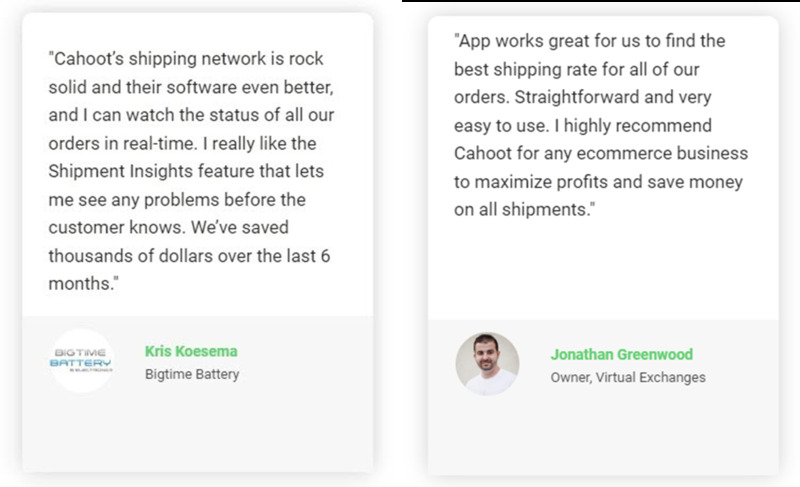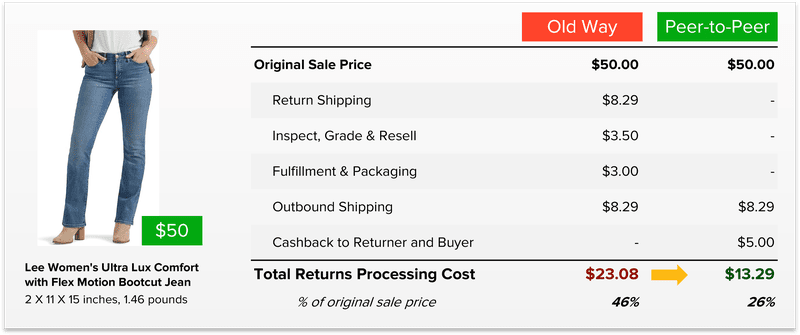Ecommerce Shipping Software: Top Benefits of Using Shipping Software in 2025

Last updated on March 20, 2025

In this article
 12 minutes
12 minutes
- Key Takeaways
- Why Use Ecommerce Shipping Software?
- How to Choose the Right Shipping Software for Your Business
- Enhancing Customer Experience with Shipping Software
- International Shipping Considerations
- Leveraging Analytics and Reporting
- Security and Compliance in Shipping Software
- Cahoot Ecommerce Shipping Software Solution
- Summary
- Frequently Asked Questions
Ecommerce shipping software automates crucial shipping tasks for online retailers, promoting efficiency and reducing costs. In this article, we’ll review the top 8 ecommerce shipping software solutions for 2025 and explore how they can improve your shipping process and customer satisfaction.
Key Takeaways
- Ecommerce shipping software automates the order fulfillment process, improving efficiency and reducing costs for online retailers.
- Key features to consider when selecting shipping software include integration capabilities, multi-carrier support, real-time tracking, and automated label creation and printing.
- Effective shipping solutions not only enhance customer satisfaction through timely deliveries and streamlined returns management but also provide valuable analytics for optimizing shipping operations.
Why Use Ecommerce Shipping Software?
Ecommerce shipping software automates and manages the order fulfillment process, making it indispensable for online retailers. These solutions streamline operations involved in freight delivery, such as searching for carriers, printing shipping labels, comparing shipping rates, and tracking shipments.
The right shipping software not only improves efficiency but also reduces costs, providing transparency in shipping expenses and ensuring reliable delivery.
Key Features to Look For
When evaluating ecommerce shipping software, consider the following key features:
- Integration capabilities: Seamless connections with various ecommerce platforms and sales channels ensure smooth data flow and reduce manual data entry and errors stemming from obsolete data.
- Multi-carrier support: This allows businesses to choose from a variety of shipping carriers and services, providing flexibility and adaptability to different needs.
- Real-time tracking: Offers updates and notifications regarding shipment status, providing transparency for both retailers and customers.
- Automated label creation and printing: Streamlines shipping workflows and allows for customization options that align with brand identity.
By focusing on these features, you can select the best ecommerce shipping software for your business needs.
The ideal shipping software should offer a clean and user-friendly interface that allows businesses to choose shipping software to manage shipping tasks with just a few clicks. Some platforms even provide a free plan, making them accessible to businesses of all sizes. These features ensure that the software is not only effective but also easy to implement and use, contributing to overall operational efficiency.
Benefits for Online Retailers
Ecommerce shipping software offers significant benefits for online retailers. One of the primary advantages is cost efficiency. By optimizing carrier selection, these solutions help reduce shipping expenses, positively impacting profit margins. Streamlined shipping workflows speed up the packing and dispatching process, saving time and reducing errors. This automation is particularly beneficial for small businesses, enabling them to meet growing customer demands while maintaining efficiency.
In addition to reducing costs, shipping software can provide exclusive shipping discounts and instant savings to reduce shipping costs, further enhancing profitability. These platforms often integrate with multiple carriers, offering discounted shipping rates that are not available through direct negotiations.
Ecommerce shipping solutions improve operational efficiency and offer better shipping options. These boost customer satisfaction and retention, contributing to a more successful online store.
How to Choose the Right Shipping Software for Your Business
Choosing the right ecommerce shipping solution involves understanding your business model and specific needs. Key considerations include integration capabilities, scalability, and cost.
You’ll want to select software that meets your operational requirements and promotes peak efficiency, ultimately boosting customer satisfaction by meeting the expectations set during checkout.
Assessing Your Shipping Volume
Matching your shipping software’s capabilities with your shipping volume is essential for managing fluctuations during peak seasons or as your business scales. Many shipping solutions offer tiered pricing based on volume, significantly affecting overall shipping expenses. For businesses with high order volumes, features like bulk label printing can simplify the shipping process and save significant amounts of time.
As sales volume increases, inefficiencies in manual shipping processes become more pronounced, making it necessary to use advanced tools for processing hundreds or thousands of orders a day. Choosing software that can scale with your shipping volume ensures that you can handle seasonal spikes or consistent growth without compromising efficiency.
Evaluating Integration Capabilities
Integration with ecommerce platforms and carriers is crucial for smooth data flow and reducing manual data entry that leads to expensive errors. Solutions that support comprehensive carrier integrations, for example, provide flexibility that allows businesses to access multiple delivery options, compare real-time shipping rates, and create the best service level agreements for shipments. Choosing shipping software that easily connects with other applications can streamline processes and improve overall performance.
Comparing Costs and Discounts
When selecting shipping software, it’s essential to compare costs and look for exclusive shipping discounts. Real-time carrier rates allow businesses to quickly compare shipping costs from different providers, ensuring the best deal for each shipment. Platforms like Cahoot and Easyship provide access to pre-negotiated shipping rates, enabling cost savings for users that are unattainable otherwise. Detailed reports on Shipment Insights (claims, damages, and carrier performance) can help businesses identify cost-saving opportunities and make data-driven decisions to optimize their shipping strategy.
Enhancing Customer Experience with Shipping Software
Improving customer satisfaction through timely deliveries is a key advantage of utilizing ecommerce shipping software. These platforms enhance the delivery experience by providing timely updates on shipping statuses and reducing inquiry volumes.
Features like real-time tracking and streamlined returns management play a significant role in boosting customer satisfaction and retention.
Real-Time Tracking and Notifications
Real-time tracking features in shipping software enable customers to monitor their package status throughout the delivery process. This transparency is central to reducing customer anxiety and improving overall satisfaction. Automated notifications provide timely updates about order status, ensuring that customers are always informed about their shipments.
Effective shipping software should offer branded tracking communications, enhancing the customer experience by aligning with the business’s brand identity, while offering the ability to promote other offerings along with discounts for future purchases. Real-time updates also help streamline order imports and inventory management, ensuring that businesses can meet customer expectations with greater accuracy and efficiency.
Streamlined Returns Management
Streamlined returns management is another critical feature of effective shipping software. An integrated returns portal allows businesses to manage return requests efficiently, ensuring prompt customer refunds and improving the overall customer experience. Shipping software should include automation functionalities like a self-serve return portal, return tracking updates, and refund automation to enhance efficiency and customer retention.
Efficient returns management not only simplifies the process for customers but also aids merchants in recovering value from returned goods. By offering features such as branded tracking pages and the capability for customers to generate return labels quickly, shipping software can make the returns process less cumbersome and more user-friendly. Modern ecommerce shipping software offers peer-to-peer returns to save merchants nearly 70% of the reverse logistics costs while supporting sustainability.
International Shipping Considerations
Navigating the complexities of international shipping requires robust ecommerce shipping solutions that support global carrier integration and customs generation. Effective international shipping strategies are essential for online retailers looking to expand their market reach and improve their global delivery experience.
Automating Customs and Duties
Automating customs documentation and duties calculation is vital for efficient international shipping. Manually configuring customs forms can be time-consuming and error-prone, but shipping software that automates these tasks helps streamline workflows and reduce shipping expenses. The automation of HS Codes, Declared Value, Manufacturer Name, Country of Origin, and Brief Description of the shipment contents, as well as support for DDU and DDP (Delivered Duty Unpaid or Paid) is priceless feature for managing the complexities of international shipments, ensuring compliance with various regulations and minimizing customs delays.
Managing Cross-Border Logistics
Managing cross-border logistics effectively is essential for maintaining customer satisfaction and operational efficiency in international ecommerce. Handling non-delivery reports promptly and efficiently ensures that customers remain informed, fostering loyalty and repeat business. Best practices in managing logistics can streamline operations and reduce instances of non-delivery, contributing to a more favorable delivery experience.
Implementing strategies for managing cross-border logistics, such as integrating with global carrier networks and automating customs processes, can significantly enhance the efficiency of international shipping. These practices help businesses navigate the complexities of international shipping, ensuring timely deliveries and improving overall customer satisfaction.
Leveraging Analytics and Reporting
Leveraging analytics and reporting features in shipping software is essential for optimizing shipping operations and enhancing decision-making. These tools provide comprehensive insights into carrier performance, SLA breaches, in-transit orders, and other operational concerns, enabling businesses to make data-driven decisions that improve efficiency and service levels.
Tracking Carrier Performance
Monitoring carrier performance through analytics allows businesses to assess delivery timeliness and identify any breaches of service level agreements. Analytics tools can help quantify carrier reliability by tracking key performance indicators, such as delivery quality and timeliness. This information will help Sellers make informed decisions about carrier selection and optimizing shipping strategies.
By effectively utilizing analytics to monitor carrier performance, businesses can continually improve their shipping operations, leading to better service levels and enhanced customer satisfaction.
Tools that provide transparent rate comparisons and non-delivery reports can further aid in refining shipping strategies and ensuring reliable deliveries.
Inventory Synchronization and Demand Forecasting
Effective inventory synchronization ensures that stock levels match demand, preventing stockouts and overstock situations. Advanced shipping management solutions include demand forecasting and inventory synchronization features, enabling businesses to predict future inventory needs based on historical sales data and market trends. These capabilities help improve order fulfillment times and customer satisfaction by ensuring that sufficient inventory is available to meet customer demands.
Integrating inventory synchronization and demand forecasting into shipping software can significantly enhance operational efficiency. Aligning inventory levels with demand helps businesses optimize their supply chain, reduce costs, and improve the overall customer experience.
Security and Compliance in Shipping Software
Ensuring security and compliance in shipping software is crucial for protecting sensitive information and maintaining customer trust. Handling international trade regulations and necessary documentation efficiently is essential for smooth shipping operations and adherence to legal standards.
Data Encryption and Protection
Shipping software should use robust data encryption methods to protect sensitive information, such as customer names, addresses, email addresses, phone numbers, and payment details. Effective encryption techniques secure customer data, especially during data transfer and storage. Implementing encryption for both data at rest and data in transit helps secure customer information from unauthorized access, making it unreadable even if intercepted.
By ensuring that customer data is protected through advanced encryption methods, businesses can maintain trust and comply with data protection regulations. These security measures are essential for safeguarding sensitive information and preventing data breaches.
Cahoot Ecommerce Shipping Software Solution
As we’ve highlighted, selecting the right ecommerce shipping software can help streamline shipping operations and improve overall efficiency. These platforms are known for their robust features, ease of use, and ability to integrate with multiple carriers and ecommerce platforms.
Cahoot stands out in the ecommerce shipping software market with the most advanced automation and cost-saving features available. It is designed to promote exceptional shipping efficiency through automatic rate shopping and label generation, processing shipping tasks significantly faster than competitors like ShipStation by over twentyfold. Cahoot uses customer information and available resources to automatically select the most cost-effective shipping label for every order, ensuring timely and cost-effective deliveries.
One of Cahoot’s key strengths is its ability to integrate seamlessly with many ecommerce platforms and carriers, providing a smooth shipping experience for users. The software’s intelligent cartonization features optimize packing to minimize shipping costs and reduce waste. Additionally, Cahoot offers access to a large network of over 100 warehouses across the U.S., enabling any ecommerce business to become a multi-warehouse operation virtually overnight with zero capital expenditure.
Cahoot also enhances accuracy and prevents expensive shipping mistakes by automatically validating customer addresses and providing alternatives when errors are detected, ensuring that orders are delivered to the correct locations the first time. This level of automation not only reduces shipping costs but also saves time, allowing merchants to quickly and efficiently fulfill orders with minimal manual input. It takes the thinking out of shipping label creation.

Summary
In conclusion, ecommerce shipping software is at the center of successful shipping operations, helping companies to reduce costs and improve customer satisfaction. The top solutions offer a range of features that cater to different business needs, from automation and ample integration options to real-time tracking and compliance management. By choosing the right shipping software, businesses can optimize their shipping strategy, streamline workflows, and stay ahead of the competition.
Frequently Asked Questions
What is ecommerce shipping software?
Ecommerce shipping software automates and manages the order fulfillment workflow, including tasks like label printing, inventory tracking, and carrier integration. This streamlines efficiency and enhances customer satisfaction.
How does shipping software help reduce costs?
Shipping software effectively reduces costs by optimizing carrier choices and granting access to discounted rates, while also automating processes to save time and minimize errors. This can lead to significant savings for businesses.
Why is real-time tracking important in shipping software?
Real-time tracking offers customers immediate updates on their shipments, improving visibility and alleviating concerns regarding delivery times. The resulting customer trust and satisfaction leads to stronger relationships and higher lifetime customer value.
What features should I look for in shipping software?
When choosing shipping software, prioritize features such as integration capabilities, multi-carrier support, real-time tracking, automated label printing, and a user-friendly interface for optimal efficiency. This will enhance your shipping experience and streamline operations.
How can shipping software improve customer satisfaction?
Shipping software enhances customer satisfaction by delivering timely updates on shipment statuses, streamlining returns management, and ensuring prompt deliveries. This transparency and efficiency significantly boost the overall customer experience.

Up to 64% Lower Returns Processing Cost


